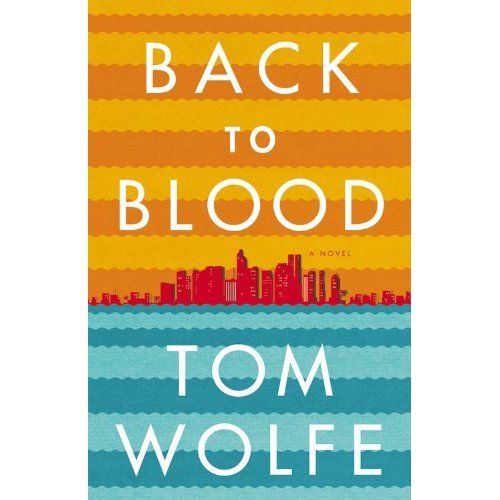About a quarter of the way through Tom Wolfe’s new novel, “Back to Blood,” pornography addiction specialist Dr. Norman Lewis waits with his nurse (and mistress) Magdelena Otero to be interviewed by a “60 Minutes” crew. Norman is delirious at the prospect of his star turn — so much so that he becomes a bit, er, overstimulated.
” ‘Now — while they’re at the door!’ ” he grunts at Magdalena, who responds, ” ‘No, Norman! Are you crazy? … There’s no time!’ “
For Wolfe, the scene offers an opportunity to push the novel into absurdity: ” ‘This is the time –‘ croaked Dr. Lewis. ‘While they’re — at — the — gate.’ ” And yet, as much as Wolfe means to highlight a larger social disintegration, his satire in “Back to Blood” feels a little thin. Throughout “Back to Blood,” Wolfe uniformly writes down to his characters, treating them less as people than as reflections in a jaundiced eye.
Taking place in Miami, a city in which, as he notes, “everybody hates everybody,” the book aspires to be a sweeping social novel in the style of “The Bonfire of the Vanities,” but instead it unfolds as a portrait gallery of noxious personalities, sketched out in the broadest strokes.
There is Norman, the sex-addicted addiction therapist, and Magdalena, whose mix of sensuality and innocence is mitigated by her disastrous taste in men. There is Nestor Camacho, as close as “Back to Blood” has to a moral center, a Cuban cop who, incredibly, finds himself at the center of four high-profile cases in the space of a few months.
Add Sergei Korolyov, the Russian “oligarch” (read: mobster) who steals Magdalena from Norman; a Haitian college professor and his children; and a Cuban mayor and black police chief, and you begin to see what Wolfe is after: to represent the component parts of a city that is, in the mayor’s words, “not a melting pot, because that’s not gonna happen, not in our lifetimes,” but rather a loose conglomeration of communities that like “all people everywhere, have but one last thing on their minds — Back to blood!”
But here’s the thing: Despite his acumen as a reporter, Wolfe has never been a particularly good novelist. The plots he creates feel contrived in comparison to those he has discovered in the world. His last novel, “I Am Charlotte Simmons” (2004), is a case in point: a college satire that reads like a pastiche, written at a distance, disconnected from experience, lived or observed.
Also: The novels are too long, 600 or more pages, and wildly overwritten. “Back to Blood” clocks in at 704.
That might not be such a problem if “Back to Blood” were really the kind of social novel that Wolfe meant to write, a true tale of the city, as it were.
His relentless use of stereotype, however — as well as his overbearing nastiness to his characters — keeps the narrative from ever fully coming to life.
The catalyst is Nestor, who, early in the novel, climbs a sailboat’s mast to bring a Cuban refugee to safety, only to be vilified when it becomes apparent that the man will be sent back. Transferred to a different police unit, he finds himself at the center of another controversy when a cellphone video of him and a fellow Cuban officer arresting a black crack dealer ends up on YouTube, complete with racial epithets.
The idea is to highlight the conflict between blacks and Cubans, which is a theme throughout the novel. (Remember that mayor and police chief?) But the effect is to test the bounds of credibility, especially when Nestor draws the attention of a Miami Herald reporter named (really) John Smith, “a mere boy with perfect manners and perfect posture,” who writes a pair of front page stories about the cop.
Although Smith and Nestor eventually team to investigate a possible art forgery, the relationship between them — and, indeed, the way Wolfe portrays journalism, and especially newspaper journalism, in these days of waning influence — is among the least believable aspects of the novel, melodramatic and over the top.
More to the point, the story of Smith and Nestor frames a bigger issue with the novel, since, unlike the plot line involving Norman and Magdalena, it’s not played for satiric effect.
Wolfe also mocks Smith and Nestor, deriding the reporter for how he dresses and portraying Nestor as a peacock, obsessed with his physique.
The focus on appearance is telling, for Wolfe is, as he has always been, fascinated by surfaces, by the way they reveal us, often in spite of ourselves. But with “Back to Blood,” he has given us a novel composed almost entirely of surfaces, with very little substance underneath.
Copy the Story Link
Send questions/comments to the editors.



Success. Please wait for the page to reload. If the page does not reload within 5 seconds, please refresh the page.
Enter your email and password to access comments.
Hi, to comment on stories you must . This profile is in addition to your subscription and website login.
Already have a commenting profile? .
Invalid username/password.
Please check your email to confirm and complete your registration.
Only subscribers are eligible to post comments. Please subscribe or login first for digital access. Here’s why.
Use the form below to reset your password. When you've submitted your account email, we will send an email with a reset code.